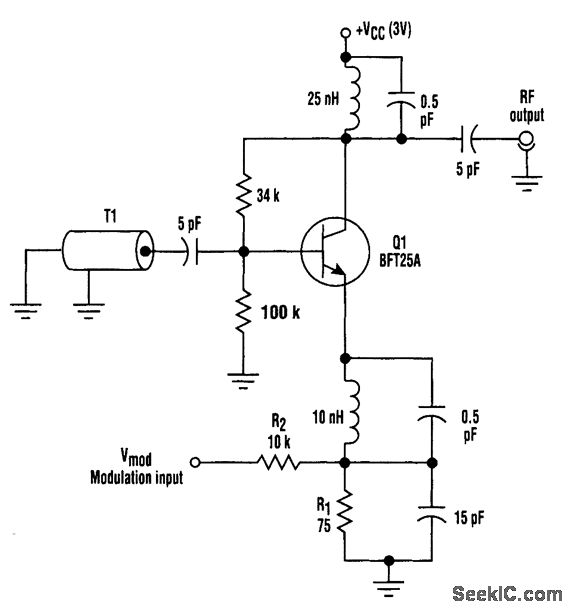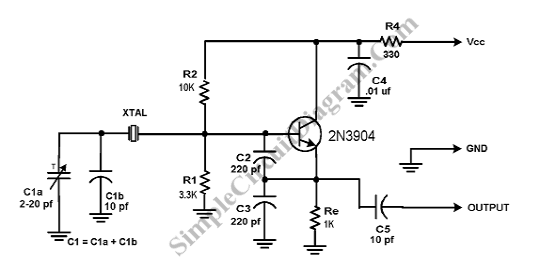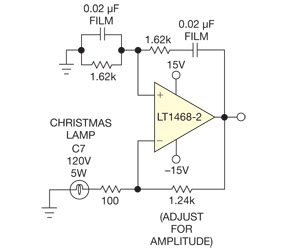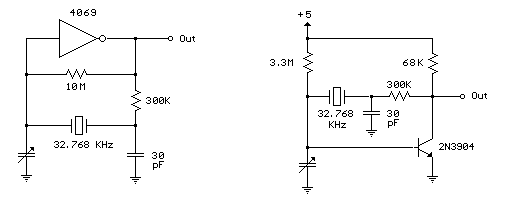
FM HF OSCILLATOR WITH NO VARACTOR

This circuit utilizes base-charging capacitance modulation instead of a varactor to frequency-modulate a high-frequency oscillator. This approach eliminates the significant voltage change required by a varactor, which can pose challenges in battery-powered systems with limited supply voltages. T1 serves as a ceramic coaxial quarter-wave resonator.
The described circuit presents an innovative solution for frequency modulation in high-frequency oscillators by leveraging base-charging capacitance modulation. This method is particularly advantageous in applications where maintaining low power consumption is critical, such as in portable and battery-operated devices. By avoiding the use of a varactor, the circuit mitigates the issues associated with the substantial voltage swings that typically accompany varactor-based modulation systems.
The ceramic coaxial quarter-wave resonator, designated as T1, plays a pivotal role in this configuration. The resonator is designed to resonate at a specific frequency, which is determined by its physical dimensions and the dielectric properties of the ceramic material. This resonant behavior allows for efficient energy transfer and stability in frequency modulation, enhancing the overall performance of the oscillator.
In this circuit, the modulation of frequency is achieved through the manipulation of the capacitance at the base of the oscillator. As the base-charging capacitance varies, it directly influences the oscillation frequency, allowing for precise control without the drawbacks of high voltage requirements. This approach not only simplifies the design but also improves the reliability and efficiency of the oscillator in various applications, including telecommunications and signal processing.
Overall, this circuit design exemplifies a practical and effective method for achieving frequency modulation in high-frequency oscillators, providing an alternative that is particularly suitable for low-voltage environments.Instead of using a varactor to frequency-modulate a high-frequency oscillator, this circuit uses base-charging capacitance modulation. Consequently, the large voltage change required by a varactor, which can be a major problem in battery-powered systems with limited supply voltages, is elimtnated.
T1 is a ceramic coaxial quarter-wave resonator. 🔗 External reference
The described circuit presents an innovative solution for frequency modulation in high-frequency oscillators by leveraging base-charging capacitance modulation. This method is particularly advantageous in applications where maintaining low power consumption is critical, such as in portable and battery-operated devices. By avoiding the use of a varactor, the circuit mitigates the issues associated with the substantial voltage swings that typically accompany varactor-based modulation systems.
The ceramic coaxial quarter-wave resonator, designated as T1, plays a pivotal role in this configuration. The resonator is designed to resonate at a specific frequency, which is determined by its physical dimensions and the dielectric properties of the ceramic material. This resonant behavior allows for efficient energy transfer and stability in frequency modulation, enhancing the overall performance of the oscillator.
In this circuit, the modulation of frequency is achieved through the manipulation of the capacitance at the base of the oscillator. As the base-charging capacitance varies, it directly influences the oscillation frequency, allowing for precise control without the drawbacks of high voltage requirements. This approach not only simplifies the design but also improves the reliability and efficiency of the oscillator in various applications, including telecommunications and signal processing.
Overall, this circuit design exemplifies a practical and effective method for achieving frequency modulation in high-frequency oscillators, providing an alternative that is particularly suitable for low-voltage environments.Instead of using a varactor to frequency-modulate a high-frequency oscillator, this circuit uses base-charging capacitance modulation. Consequently, the large voltage change required by a varactor, which can be a major problem in battery-powered systems with limited supply voltages, is elimtnated.
T1 is a ceramic coaxial quarter-wave resonator. 🔗 External reference




